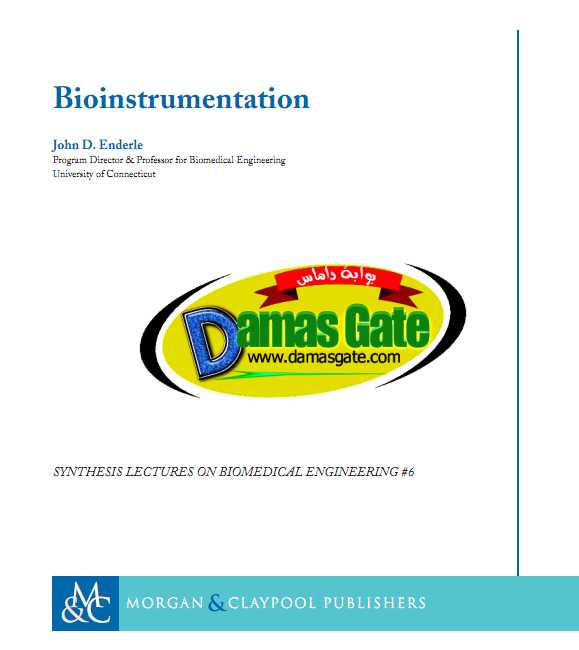Bioinstrumentation - John D. Enderle

ABSTRACT
This short book provides basic information about bioinstrumentation and electric circuit theory.
Many biomedical instruments use a transducer or sensor to convert a signal created by the body
into an electric signal. Our goal here is to develop expertise in electric circuit theory applied
to bioinstrumentation. We begin with a description of variables used in circuit theory, charge,
current, voltage, power and energy. Next, Kirchhoff ’s current and voltage laws are introduced,
followed by resistance, simplifications of resistive circuits and voltage and current calculations.
Circuit analysis techniques are then presented, followed by inductance and capacitance, and
solutions of circuits using the differential equation method. Finally, the operational amplifier
and time varying signals are introduced. This lecture is written for a student or researcher or
engineer who has completed the first two years of an engineering program (i.e., 3 semesters of
calculus and differential equations). A considerable effort has been made to develop the theory
in a logical manner—developing special mathematical skills as needed. At the end of the short
book is a wide selection of problems, ranging from simple to complex.
KEYWORDS
Bioinstrumentation, Circuit Theory, Introductory Biomedical Engineering, Sensors,
Transducers, Circuits, Voltage, Current
Preface
This short book on bioinstrumentation is written for a reader who has completed the first two
years of an engineering program (i.e., three semesters of calculus and differential equations).
A considerable effort has been made to develop the theory in a logical manner—developing
special mathematical skills as needed.
I have found it best to introduce this material using simple examples followed by more
difficult ones.
At the end of the short book is a wide selection of problems, ranging from simple to
difficult, presented in the same general order as covered in the textbook.
I acknowledge and thank William Pruehsner for the technical illustrations. Portions of
this short book are from Chapter 8 of Enderle, J. D., Blanchard, S. M., and Bronzino, J. D.,
Introduction to Biomedical Engineering (Second Edition), Elsevier, Amsterdam, 2005, 1118 pages,
with Sections 1, 2 and 13 contributed by Susan Blanchard, Amanda Marley, and H. Troy Nagle.
Download
http://s18.alxa.net/s18/srvs2/02/003....D.Enderle.rar

ABSTRACT
This short book provides basic information about bioinstrumentation and electric circuit theory.
Many biomedical instruments use a transducer or sensor to convert a signal created by the body
into an electric signal. Our goal here is to develop expertise in electric circuit theory applied
to bioinstrumentation. We begin with a description of variables used in circuit theory, charge,
current, voltage, power and energy. Next, Kirchhoff ’s current and voltage laws are introduced,
followed by resistance, simplifications of resistive circuits and voltage and current calculations.
Circuit analysis techniques are then presented, followed by inductance and capacitance, and
solutions of circuits using the differential equation method. Finally, the operational amplifier
and time varying signals are introduced. This lecture is written for a student or researcher or
engineer who has completed the first two years of an engineering program (i.e., 3 semesters of
calculus and differential equations). A considerable effort has been made to develop the theory
in a logical manner—developing special mathematical skills as needed. At the end of the short
book is a wide selection of problems, ranging from simple to complex.
KEYWORDS
Bioinstrumentation, Circuit Theory, Introductory Biomedical Engineering, Sensors,
Transducers, Circuits, Voltage, Current
Preface
This short book on bioinstrumentation is written for a reader who has completed the first two
years of an engineering program (i.e., three semesters of calculus and differential equations).
A considerable effort has been made to develop the theory in a logical manner—developing
special mathematical skills as needed.
I have found it best to introduce this material using simple examples followed by more
difficult ones.
At the end of the short book is a wide selection of problems, ranging from simple to
difficult, presented in the same general order as covered in the textbook.
I acknowledge and thank William Pruehsner for the technical illustrations. Portions of
this short book are from Chapter 8 of Enderle, J. D., Blanchard, S. M., and Bronzino, J. D.,
Introduction to Biomedical Engineering (Second Edition), Elsevier, Amsterdam, 2005, 1118 pages,
with Sections 1, 2 and 13 contributed by Susan Blanchard, Amanda Marley, and H. Troy Nagle.
Download
http://s18.alxa.net/s18/srvs2/02/003....D.Enderle.rar